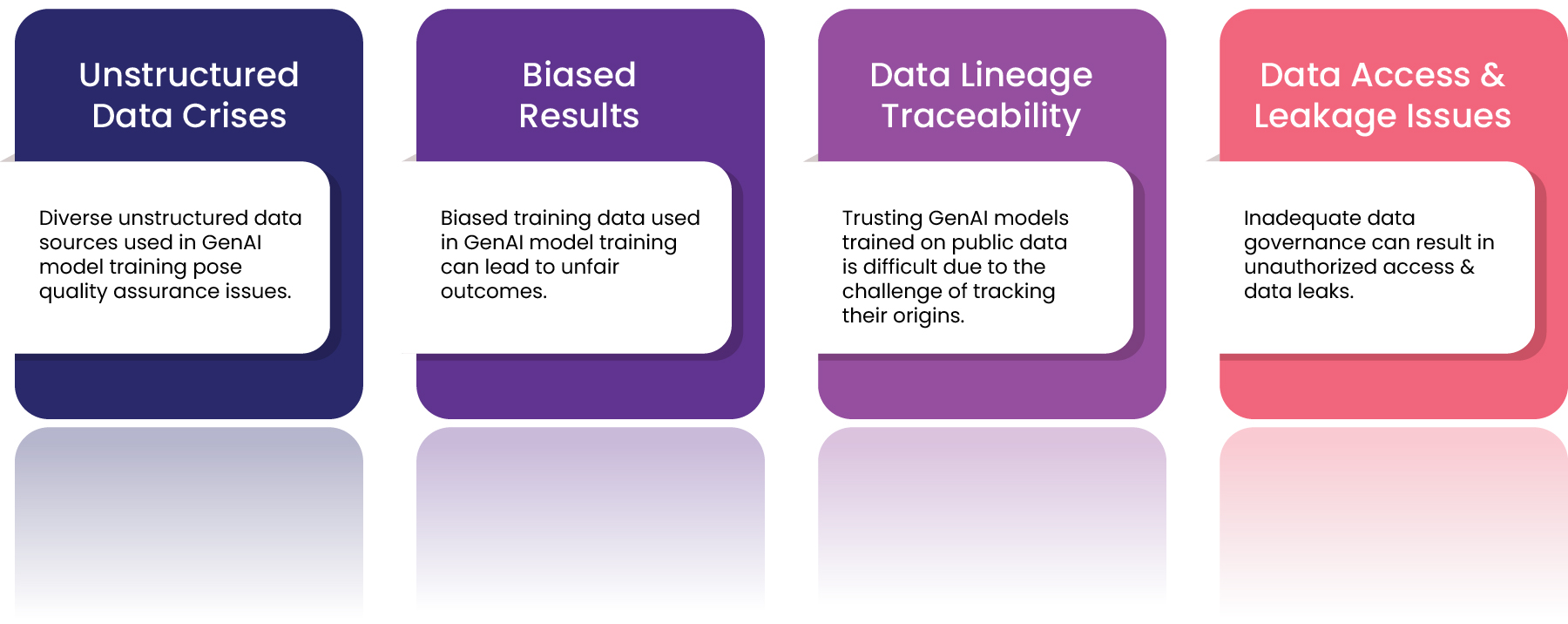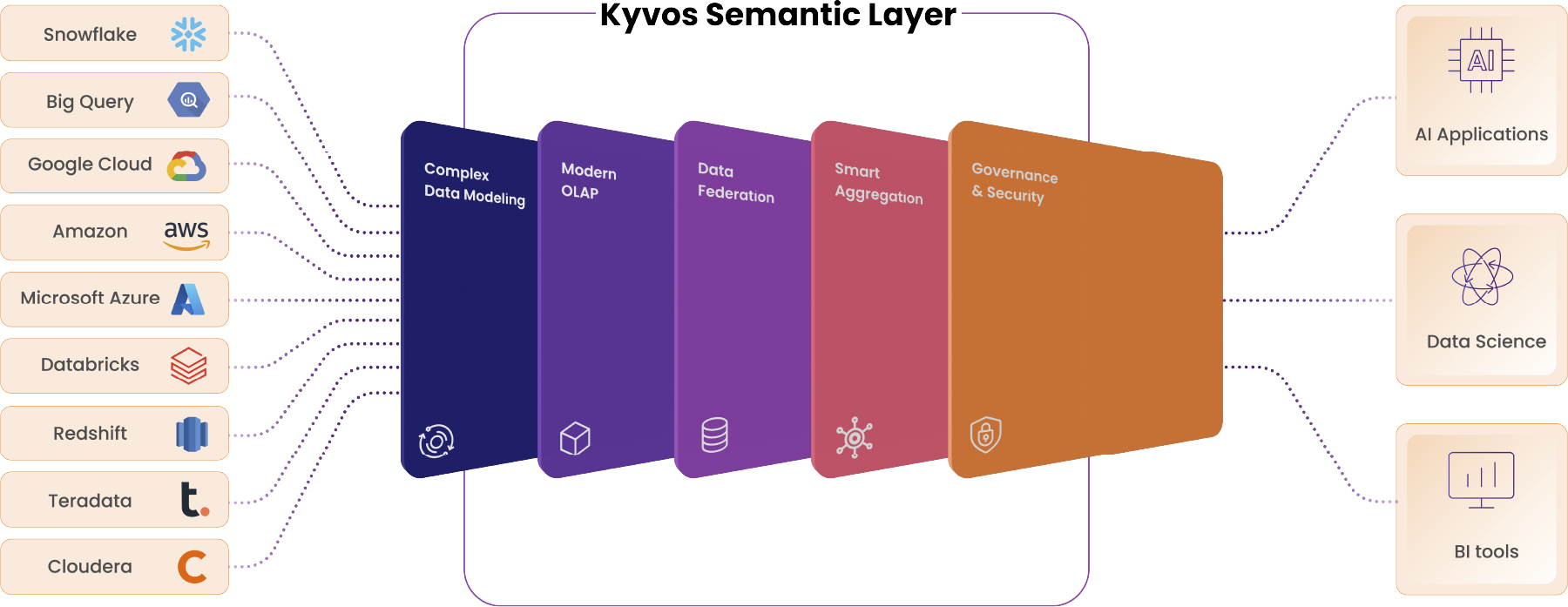What this blog covers:
- Data Governance challenges in GenAI adoption
- How semantic layer refines LLMs responses and ensure accurate insights.
- How Kyvos’ GenAI-powered semantic layer reinvent AI governance.
Semantic Layer: The Key to Confident GenAI Adoption
Organizations worldwide are embracing GenAI to transform their interactions with data. The technology leans heavily on dynamic data to generate exceptional human-like text, images and even music.
Most AI models are trained on massive structured or unstructured datasets to produce predictions, recommendations and categorization. Therefore, organizations must feed high-quality, accurate data to these models for precise outcomes. Failing to adopt standard data governance strategies may beget biased outputs leading to data mismanagement and security breaches.
Data Governance and Its Challenges
Data governance is already an aching point for many companies, especially those generating tremendous volumes of sensitive data . GenAI makes the data governance process more challenging . Sure, it helps organizations enhance customer services, automate manual processes and create value in more ways than one can envision. Nevertheless, it’s true that these models also obligate companies to ensure data integrity. Because of this predicament, businesses face a Hobson’s choice of swamping themselves with the tedious task of assuring data quality or risking the consequences of biased outputs and unreliable insights.
Here are several challenges that surpass the opportunities that GenAI brings to data governance

- Unstructured data crises: Companies don’t classify and label unstructured data within a database. Everything from email to YouTube videos is stored in these databases. GenAI models use these diverse and extensive datasets as fuel for their training. So basically, the models are trained on data that might be meaningless, crooked or comprised of missing values and noise. Massive volume and complexity make it more challenging for enterprises to understand all this data and ensure its quality.
- Biased results: Biased training data often delivers biased outputs. For instance, a GenAI model that automates loan application approvals is trained on partial historical data with higher loan rejection rates for some ethnicities. As a result, the model will generate biased outputs for favored ethnicities and might decline loan applications of customers who pass the loan criteria but fall under non-favored ethnicity.
- Data lineage traceability: Capturing and preserving cross-system lineage data is typically a complicated and time-consuming effort. The output of GenAI models trained on publicly exposed data cannot be trusted. This data is sourced from many origins and tracking its journey from origin to destination is tricky. Knowing the blueprint of the data’s journey ensures its quality and accuracy.
- Data access and leakage issues: Organizations with poor data governance policies may reveal their data to intruders. These intruders try to gain unauthorized access by asking sneaky questions and bypassing conventional access controls. Moreover, not having a consistent way of operating data also risks data leakage during the GenAI model training process.
These challenges are why modern organizations are holding themselves back from implementing GenAI to automate their day-to-day tasks.
Bridging the Gap Between Information and Insights with Semantic Layer
Large Language Models (LLMs) are a vast library of knowledge trained on massive datasets using deep learning techniques. It merely understands the organization’s domain-specific terminology and hence, they hallucinate. Let’s think of it as a puzzle, where puzzle pieces are data scattered inconsistently. Now, it would be difficult for us to make sense of the pieces that are put upside down and we might wrongly place them. The same happens with LLMs trying to comprehend inconsistent and unstructured data. They produce wrong answers. Understanding enterprise data’s context and semantics is paramount for these models to operate accurately and deliver the correct answers.
This is why a semantic layer is introduced as a librarian to these models, which bridges the gap between business logic and data language to refine the responses. It systematizes data into meaningful definitions and privileges LLMs to query data through it rather than directly querying the database. Furthermore, the semantic layer introduces specificity to these models to produce accurate and relevant responses based on the context. For instance, human language is filled with idioms, cultural references and slang. So, when someone says “feeling under the weather,” they are not discussing the weather. Instead, they are implying that they are feeling unwell. This is how the semantic layer helps LLMs navigate these linguistic barriers and solve the hallucination problem.
Reinventing AI Governance with a GenAI Powered Semantic Layer
The progression of data governance to AI governance can easily be covered with the inclusion of a semantic layer. AI governance creates frameworks that ensure AI’s responsible and ethical use. Without a robust data governance framework, one can never be sure of the accuracy of the output generated by generative AI models. For instance, if a query is executed to compare sales for different product categories in the USA over the past quarter. The GenAI model might pull data from diverse datasets like Salesforce or finance. In this case, the semantic layer acts as a middleman to make sure that the data retrieved is consistent, accurate and relevant. A GenAI-powered semantic layer, like Kyvos, breaks data silos and acts as a modern layer of business abstraction.

It provides a comprehensive data view by uniformly maintaining business metrics, data access rules, calculation logic, etc. Think of it as a lens that scans infinite raw data streams and creates a summary for GenAI models. It can introduce context to the querying process, aiding LLMs in reaching accurate results. So, when a query fired has ambiguities, it alerts the user for clarification. In addition, the three-tiered security architecture of Kyvos’ semantic layer executes role-based access controls to prevent unauthorized data access and leakage.
In Conclusion
Today, every organization is looking to take advantage of GenAI by automating everyday tasks, modernizing business intelligence and much more. However, they cringe because of the data governance challenges these models pose. Organizations can assist all governance needs with a GenAI-powered semantic layer in the data architecture.

